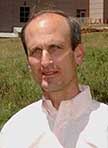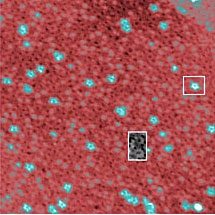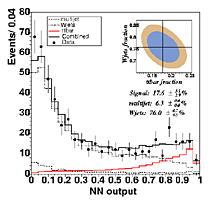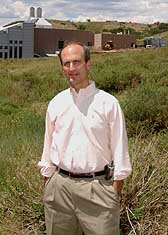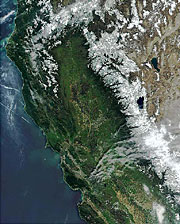Research
Highlights...
|
 |
| Number 166 |
September 7, 2004 |
Telomere crisis: A crucial stage in breast cancer
|
Telomere crisis occurring during ductal hyperplasia (left) may lead to carcinoma in situ. |
Researchers have established that "telomere crisis" is an important early event in the development of breast cancer, and that its occurrence can be identified with precision. In all cells, telomeres on chromosome ends regulate replication. Crisis occurs if telomeres become too short and damage-control mechanisms activate to kill unstable cells. Occasionally cells in a milk-collecting duct proliferate excessively (hyperplasia) and, rarely, may escape cell death, survive the telomere crisis, and go on to form the first stage of breast cancer (carcinoma in situ). Joe Gray, director of the Life Sciences Division at DOE's Berkeley Lab and a professor at the University of California at San Francisco, led the research team.
[Paul Preuss, 510/486-6249;
paul_preuss@lbl.gov]
|
|
'Starfish' form on quasicrystalline substrate
Researchers at DOE's Ames Laboratory have discovered "starfish" dwelling at specific sites on the surface of quasicrytalline substrate. Using thin-film techniques to deposit an atoms-thin layer of aluminum on a clean, quasicrystalline substrate, they've found that clusters of five atoms of aluminum that gather in a star shape around 2 Å-deep holes in the surface of the materials. At this point, it's not clear if a sixth atom locates in the center hole. "The surface is dictating the nucleation," says Ames Laboratory senior chemist Pat Thiel, "and the pentagonal symmetry is not what the aluminum atoms would adopt in the bulk." The discovery holds promise in helping develop nano-scale materials with quasicrystalline properties.
[Kerry Gibson, 515/294-1405;
kgibson@ameslab.gov]
|
|
A new view from the top at Fermilab's CDF?
|
|
Distribution of the neural network output in W+>=3 jet events, compared to the result of the fit. (Click to enlarge)
|
The production of top-antitop quark pairs at DOE's Fermilab Tevatron
provides a unique arena for tests of the Standard Model and searches
for new particles—including a possible t' particle, heavier than the
top quark but with similar decay signatures. A team at the CDF
collider detector, from Fermilab, Ohio State, and Rutgers, has
measured the rate of top-antitop production in events with a
high-energy electron or muon and three or more jets, using only the
total transverse energy variable ("HT") to distinguish top events
from background. A fit of the observed HT distribution to a
combination of W+jets, top-antitop, and t'-anti-t' events rules out a
t' quark with mass similar to the top quark. But with more data, the
team will search for t' with ever-higher masses.
[Mike Perricone, 630/840-5678;
mikep@fnal.gov]
|
|
Computer tool to save archaeological treasures
A new geographic computer system sifts through mounds of data to help find and map archaeological sites at the DOE's Idaho National Engineering and Environmental Laboratory, in an effort to protect artifacts—from 12,000-year-old mammoth bones to 150-year-old pioneer homesteads—on its 890-square-mile site. To help archaeologists save time, money, and maybe some digging, computer scientists created software that links historical, anthropological, and archaeological databases with Geographic Information System technology. A mathematical model even suggests sites for exploration—using information such as rivers and old travel routes to guess where hunter-gatherer families may have left behind tangible traces of their lives.
[Regina Nuzzo, 208/526-3176,
nuzzrl@inel.gov]
|
|
|
|
Science and Technology Facility: A New Way of Doing Research at NREL
Pete Sheldon has been spending countless hours pouring over architectural drawings. This is new territory for Sheldon, manager of DOE's National Renewable Energy Laboratory's National Center for Photovoltaic's Measurements and Characterization Division.
During the last couple years, Sheldon has been wearing the additional hat of Technical Project Manager for the Laboratory's new Science and Technology Facility (S&TF). This role has him, among other things, scrutinizing construction plans and timelines for the benefit of future research on solar cells, thin-film materials and nanostructures.
"This new facility will support research on thin-film photovoltaics and nanostructures in an environment designed to be a laboratory research facility first and foremost," Sheldon said. "Going into this project, our emphasis was on designing a state-of-the-art research facility with flexible laboratory space. The facility was designed around an innovative process integration concept that ultimately will reduce the time it takes to move technologies from the lab to the marketplace."
The centerpiece of the building will be the Process Development and Integration Laboratory (PDIL)—10,170 square feet of laboratory space specifically designed to accommodate a new class of thin film photovoltaics (PV) deposition, processing and characterization tools. The process integration concept, proposed by Sheldon, will allow researchers to pass samples between equipment in a controlled way, avoiding contamination from the air. The PDIL also will allow a scientist to integrate control systems and databases in such a way that someone who is growing a sample can see results of a measurement and vice versa.
The S&TF will support new ways of doing research on several of the technologies highlighted in President Bush's National Energy Policy, including the development of next-generation energy technologies such as hydrogen and fuel cells.
Construction of the Science and Technology Facility is expected to begin this fall and be completed in about two years.
Submitted by DOE's National Renewable Energy Laboratory
|
|
